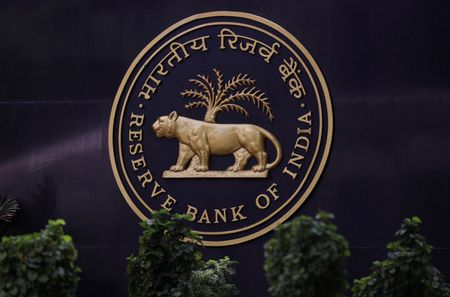By Swati Bhat
MUMBAI (Reuters) -India’s central bank said on Thursday that the economy’s natural rate of interest has increased since the pandemic and will rise further, driven by the growth of potential output, which analysts said could limit the scope to ease monetary policy.
The natural rate of interest is associated with an economy operating at full capacity without generating inflationary pressures, and though not observable, it serves as a reference point for monetary policy, the Reserve Bank of India said in its monthly bulletin.
It estimated the natural rate was 1.4-1.9% in the fourth quarter of 2023-24, higher than the 0.8-1.0% in the third quarter of 2021-22, the last time it made an estimate, the central bank said.
“When the policy rate is set below the natural rate, the stance is regarded as accommodative, and the converse signifies a restrictive stance. The policy stance is neutral when the real policy rate is at the level of the natural rate,” the RBI said.
Currently, with inflation at 5.1% and the central bank’s key lending rate set at 6.5%, the real rate stands at 1.4%. That could increase to 2% based on the RBI’s estimate of an average inflation rate of 4.5% for this fiscal year.
As such, the RBI’s wide estimate for the fourth quarter fed into the narrative of both its hawkish and dovish monetary policy committee members, said Gaura Sen Gupta, chief economist at IDFC First Bank.
“The lower range of the neutral rate indicates space to cut interest rates by 50 basis points in FY25, while the upper range indicates no space to cut rates. We maintain expectations of a shallow rate cut cycle starting from October/December,” she said.
The RBI said the forces propelling rising investment demand will likely also drive the natural rate of interest and estimated the growth of potential output at 5.9% to 8.3%.
On prices, the central bank said disinflation has been grudging and uneven, and that it was important to “stay the course” to ensure inflation drops to its target of 4% from around 5% currently.
“The argument that food price shocks are transitory does not seem to be borne out by the actual experience over the past one year – too long a period for a shock to be termed as transitory!,” the RBI said.
Still, inflation does not have to reach and stay at 4% for it to consider changing its monetary policy stance, but even an “enduring movement” to the target can be a signal for a pivot, the RBI said.
(Reporting by Swati Bhat, additional reporting by Siddhi Nayak and Ira Dugal; editing by Savio D’Souza)





